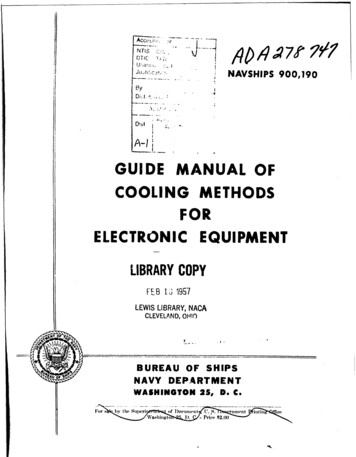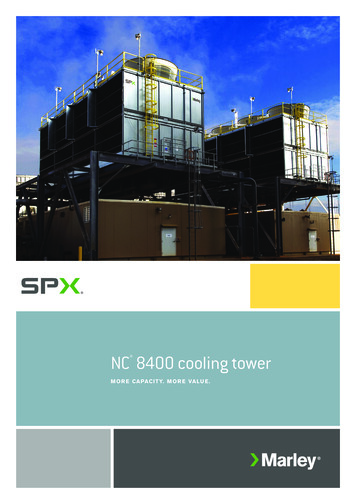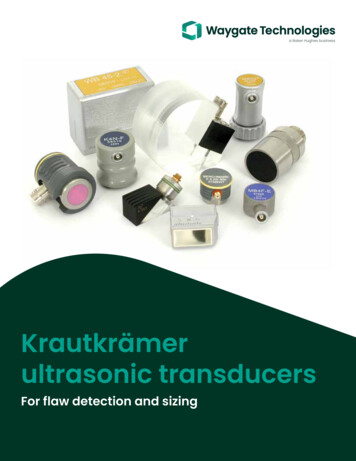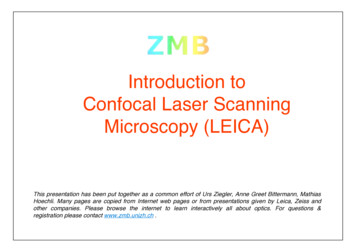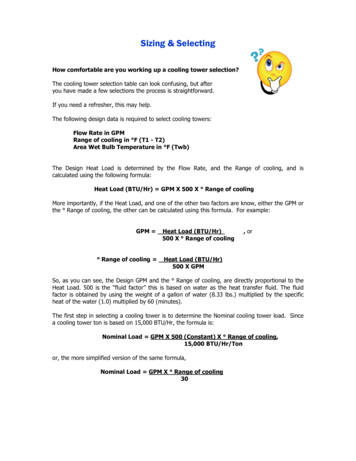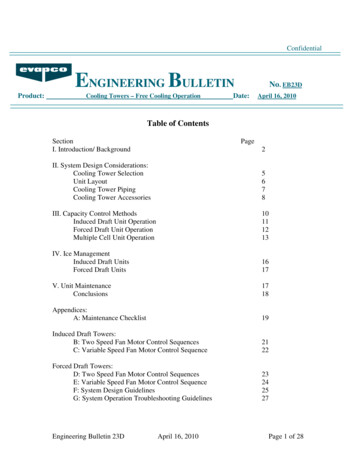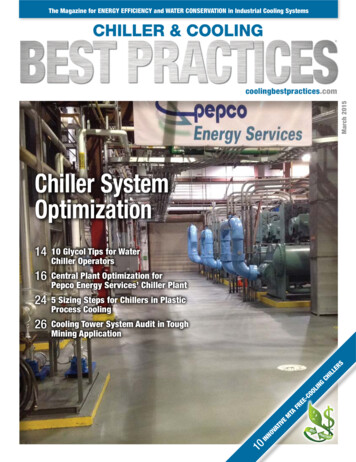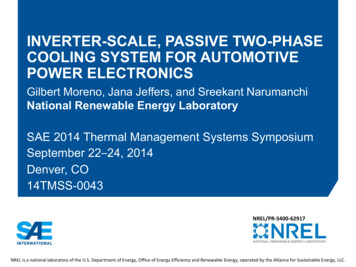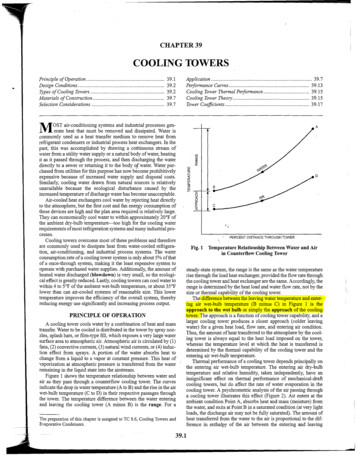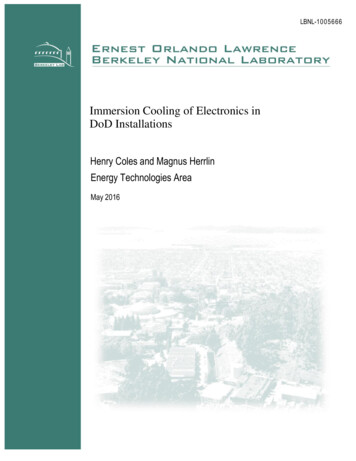
Transcription
LBNL-1005666Immersion Cooling of Electronics inDoD InstallationsHenry Coles and Magnus HerrlinEnergy Technologies AreaMay 2016
DISCLAIMERThis document was prepared as an account of work sponsored by the United StatesGovernment. While this document is believed to contain correct information, neither theUnited States Government nor any agency thereof, nor The Regents of the University ofCalifornia, nor any of their employees, makes any warranty, express or implied, orassumes any legal responsibility for the accuracy, completeness, or usefulness of anyinformation, apparatus, product, or process disclosed, or represents that its use would notinfringe privately owned rights. Reference herein to any specific commercial product,process, or service by its trade name, trademark, manufacturer, or otherwise, does notnecessarily constitute or imply its endorsement, recommendation, or favoring by theUnited States Government or any agency thereof, or The Regents of the University ofCalifornia. The views and opinions of authors expressed herein do not necessarily state orreflect those of the United States Government or any agency thereof or The Regents ofthe University of California.
ABSTRACTA considerable amount of energy is consumed to cool electronic equipment in datacenters. A method for substantially reducing the energy needed for this cooling wasdemonstrated. The method involves immersing electronic equipment in a non-conductiveliquid that changes phase from a liquid to a gas. The liquid used was 3M Novec 649.Two-phase immersion cooling using this liquid is not viable at this time. The primaryobstacles are IT equipment failures and costs. However, the demonstrated technology metthe performance objectives for energy efficiency and greenhouse gas reduction. Beforecommercialization of this technology can occur, a root cause analysis of the failuresshould be completed, and the design changes proven.
Table of Contents1.0INTRODUCTION . 11.1BACKGROUND . 11.2OBJECTIVE OF THE DEMONSTRATION. 11.3REGULATORY DRIVERS . 22.0TECHNOLOGY DESCRIPTION . 42.1TECHNOLOGY OVERVIEW. 42.2TECHNOLOGY DEVELOPMENT . 62.3ADVANTAGES AND LIMITATIONS OF THE TECHNOLOGY . 93.0PERFORMANCE OBJECTIVES . 123.1PERFORMANCE OBJECTIVE RESULTS . 123.2PERFORMANCE OBJECTIVE METRICS . 144.0FACILITY/SITE DESCRIPTION . 214.1FACILITY/SITE LOCATION AND OPERATIONS . 234.2FACILITY/SITE CONDITIONS . 265.0TEST DESIGN . 275.1CONCEPTUAL TEST DESIGN. 275.2BASELINE CHARACTERIZATION . 315.3DESIGN AND LAYOUT OF TECHNOLOGY COMPONENTS . 325.4OPERATIONAL TESTING. 355.5SAMPLING PROTOCOLS . 365.6SAMPLING RESULTS . 386.0PERFORMANCE ASSESSMENT . 406.1IMPROVED COOLING ENERGY EFFICIENCY [PO1] . 406.2REDUCED OVERALL DATA CENTER SITE ENERGY CONSUMPTION [PO2].446.3IMPROVED COMPUTATIONAL ENERGY EFFICIENCY [PO3] . 446.4LOW CONCENTRATION OF NOVEC 649 VAPORS DURING NORMALOPERATION [PO4] . 466.5LOW CONCENTRATION OF NOVEC 649 VAPORS DURING STARTUP ORMAINTENANCE [PO5] . 49i
6.6REDUCTION IN GREENHOUSE GAS EMISSIONS [PO6] . 516.7DIELECTRIC LIQUID LOSS [PO7]. 536.8SYSTEM ECONOMICS (QUALITATIVE) [PO8]. 556.9LOWER CPU CHIP TEMPERATURES [PO9] . 606.10HIGH USER SATISFACTION, LOW NUMBER OF CONCERNS(QUALITATIVE) [PO10] . 626.11IMPROVED IT POWER DENSITY (QUALITATIVE) [PO11] . 646.12SYSTEM MAINTENANCE (QUALITATIVE) [PO12] . 677.0COST ASSESSMENT . 697.1COST MODEL . 697.2COST DRIVERS . 727.3COST ANALYSIS AND COMPARISON . 748.0IMPLEMENTATION ISSUES . 758.1REGULATIONS . 758.2END-USER CONCERNS AND DECISION-MAKING FACTORS . 758.3ELECTRONICS FAILURES . 758.4PERFLUOROISOBUTYLENE (PFIB) EXPOSURE. 788.5LIQUID LOSS . 788.6SERVICE VISIBILITY . 788.7USE OF GLOVES FOR SERVICE . 798.8LID DURABILITY . 798.9PROCUREMENT ISSUES . 799.0REFERENCES . 80APPENDICES . 82Appendix A: Points of Contact . 82Appendix B: Instrument Calibration . 83Appendix C: Simulation Model and Simulation Details . 85Appendix D: Base Case Test Measurements . 92ii
List of SDSMWNISTNOAELNPVNRLOBIPFIBPFPAPI SystemPOAmerican Society of Heating, Refrigeration, and Air-Conditioning EngineersBuilding Life Cycle Costcarbon dioxide equivalentcooling distribution unitCarbon Dioxidecentral processing unitdata centerU.S. Department of DefenseU.S. Department of Energydioctyl phthalateExecutive OrderU.S. Environmental Protection AgencyEnvironmental Security Technology Certification ProgramFederal Energy Management Programfluoroketonefield programmable gate arraygallons per minutehydrofluoroetherhigh-performance computingInfiniBandindividual rack unitinformation technologykilowatt (one thousand watts)kilowatt hourLawrence Berkeley National LaboratoryLINear equations software PACKagemillion floating point operations per secondMaterial Safety Data Sheetmega (one million) wattsNational Institute of Standards and Technologyno observed adverse effect limitnet present valueNaval Research Laboratoryopen-bath immersionperfluoroisobutyleneperfluoropropionic acidProcess Information also Greek Letter (OSIsoft tradename)Performance Objectiveiii
ppmppmVPUEpPUESDSSGISPPDGTFTRLTWAUPSWWSEparts per million by massparts per million by volumepower usage effectiveness (The Green Grid, 2015)partial power usage effectivenesssafety data sheetSilicon Graphics Inc.Special Purpose Processor Development Group (Mayo Clinic)TeraflopTechnology Readiness Leveltime weighted averageuninterruptible power supply, also uninterruptible power sourcewattwater-side economizerList of FiguresFigure 2-1: Open-Bath Immersion (OBI) Cooling Basics . 5Figure 2-2: Demonstration Cooling System Schematic. 6Figure 4-1: The Base Case Test Setup . 22Figure 4-2: Pilot Test Setup at SGI . 23Figure 4-3: Dry Cooler Outside of NRL Data Center. 24Figure 4-4: Bath Located in the NRL Data Center Room . 25Figure 4-5: NRL Demonstration Setup . 25Figure 5-1: Base Case Test Configuration . 28Figure 5-2: Pilot Test - IT Running at Full Power. . 29Figure 5-3: Immersion Case Test Installation (Demonstration) . 30Figure 5-4: Immersion System Cooling with a Dry Cooler . 30Figure 5-5: Base Case Test Sampling Point Schematic . 32Figure 5-6: Bath Components and Subsystem Reference Diagram. 33Figure 5-7: Immersion Case Test Sampling Point Schematic . 37Figure 6.1-1: IT Cooling Technology and Data Center Efficiency Combinations . 41Figure 6.1-2: Immersion Cooling - Data Center Heat Rejection Combinations. 41Figure 6.1-3: Calculated Cooling pPUE And Measured Constituents . 43Figure 6.3-1: Other Computational Energy Efficiency Results . 46Figure 6.4-1: Breathing Zone Vapor Concentration Compared to Floor Zone VaporConcentration During Normal Operation . 47Figure 6.4-2: Breathing Zone Novec 649 Vapor Measurements and Calculated 8-Hour TimeWeighted Averages for Normal Operation . 48iv
Figure 6.5-1: Startup Period Breathing Zone Novec 649 Vapor Concentration Measurements.Vertical axis is in units of ppmV. . 50Figure 6.7-1: Liquid Level and Temperature Measurement Data . 55Figure 6.8-1: BLCC Version 5.3-15 Inputs . 58Figure 6.8-2: BLCC Version 5.3-15 Calculation Summary . 59Figure 6.9-1: Base Case CPU Temperatures . 60Figure 6.9-2: Immersion Case CPU Temperatures . 61Figure 6.11-1: Base Case SGI ICE X M-Cell Maximum Density Layout . 65Figure 6.11-2: Immersion Case Layout Using Demonstrated Dimensions . 66Figure 8-1: Failed Power Supply FET (courtesy of Delta Electronics) . 75Figure 8-2: “Goop” With Whisker (courtesy of 3M). 76Figure 8-3: Metallic Whiskers (courtesy 3M) . 77Figure C-1: Low-Efficiency Data Center - Base Case A . 87Figure C-2: Low-Efficiency Data Center - Immersion (1A) Cooling Uses Building CoolingWater . 87Figure C-3: Low-Efficiency Data Center - Immersion (2A) Cooling with Added Dry Cooler . 88Figure C-4: Low-Efficiency Data Center - Immersion (3A) Cooling with Added Cooling Tower. 88Figure C-5: High-Efficiency Data Center – Base Case B. 89Figure C-6: High-Efficiency Data Center - Immersion (1B) Cooling with Building CoolingWater . 89Figure C-7: High-Efficiency Data Center - Immersion (2B) Cooling with Added Dry Cooler . 90Figure C-8: High-Efficiency Data Center - Immersion (3B) Cooling with Added Cooling Tower. 90List of TablesTable 3-1: Performance Objective Results . 12Table 5-1: Base Case Test Sampling Point Details . 36Table 5-2: Immersion Case Test Sampling Point Details . 38Table 5.6-1: Report Locations of Data and Results Figures and Tables . 39Table 6.1-1: Combinations Simulated . 41Table 6.1-2: Simulation Results Summary . 43Table 6.3-1: Compute Performance, IT Equipment Power, and Computational Energy Efficiency. 45Table 6.6-1: CDE Changes Based on Total Data Center Energy . 52Table 6.6-2: CDE Changes Based on Cooling Energy . 52Table 6.8-1: Immersion Case Results and Forecasted Data . 56Table 6.12-1: Immersion Case and Base Case Maintenance Frequency . 68v
Table 7-1: Cost Elements . 70Table B-1: Level Sensor Translation Experimental Data And Results . 84Table B-2: Liquid Level Related Conversions . 84Table C-2: Modeling Results by Component . 91Table D-1: Base Case Test Energy Input . 93Table D-2: Base Case Cooling Rack (Rack Air Cooling) Measurements and Results . 94Table D-3: Base Case CDU (Rack Liquid Cooling) Measurements and Results . 95Table D-4: Base Case Unaccounted Power . 96vi
ACKNOWLEDGEMENTSThis project was primarily supported by the U.S. Department of Defense’s EnvironmentalSecurity Technology Certification Program (ESTCP), project EW-201347, additionally supportedby the Assistant Secretary for Energy Efficiency and Renewable Energy of the U.S. Departmentof Energy under Contract No. DE-AC02-05CH11231. Collaborators on this project includedLawrence Berkeley National Laboratory (LBNL) (William Tschudi), U.S. Naval ResearchLaboratory (NRL) (Dr. Jeanie Osburn), 3M (Phil Tuma), Silicon Graphics International Corp.(SGI) (Tim McCann), Intel Corporation (Dr. Michael Patterson), and Schneider Electric (OzanTutunoglu and John Bean).The research team is very grateful for the support and guidance provided by Katelyn R. Statonand Vern Novstrup from the U.S. Navy’s Naval Facilities Engineering and ExpeditionaryWarfare Center (NAVFAC EXWC) as the ESTCP technical advisors for this project.The project could not have been completed without the technical expertise and contributionsfrom Chas Williams at NRL. We want to thank Heidi Hornstein and Dr. Sergio Tafur, also fromNRL, for providing configuration and management of the IT equipment during thedemonstration.We acknowledge the support of Russ Stacy (SGI) for his work on the baseline (Base Case) andpilot testing setup and data collection. In addition, thanks go to Cheng Lao also from SGI, for hisguidance on the application and operation of benchmarking software. We are grateful to XindiCai (Schneider-Electric) for thermal controls design and programming.Many thanks to Vali Sorell (Syska Hennessy Group) and Steve Greenberg (LBNL) for technicalguidance and development of simulation assumptions.The authors wish to thank Steve Polzer from the Mayo Clinic Special Purpose ProcessorDevelopment Group (SPPDG) for a laboratory tour, discussions, and documentation of twophase immersion cooling development activities.vii
EXECUTIVE SUMMARYIntroductionThe demonstrated two-phase open-bath immersion (OBI) cooling technology was targeted tosubstitute for, or be used in conjunction with, other electronic equipment cooling technologies tosignificantly reduce the electrical energy needed for high-performance computing (HPC) datacenter operation across the U.S. Department of Defense (DoD).In addition to the electrical energy supplied to the information technology (IT) equipment atHPC sites, a significant amount of electrical energy (cooling energy) is required to remove theheat generated by the IT equipment. In fact, energy used for cooling is often 50 to 75 percent ofthe electrical energy supplied to the electronic equipment. The demonstrated OBI technologysignificantly reduces the cooling energy by immersing the electronic equipment in a bath ofdielectric (non-conducting) liquid.The dielectric liquid used for this demonstration was 3M Novec 649 Engineered Fluid. The heatfrom the electronic components is rejected as the Novec liquid undergoes a phase change (liquidto gas). This phase change takes place at 49 C, so relatively warm cooling water can be used tocondense the vapor back to a liquid. A warm-water cooled bath is more energy efficient thantypical cooling systems that use much cooler water from compressor-based systems. The waterused to cool two-phase immersion-cooled electronics can be provided by simple, economical“dry coolers” if space allows. A dry cooler is a water-to-air heat exchanger that includes a fanplaced in the outside environment—very similar in concept to an automotive radiator.This demonstration, which took place at the U.S. Naval Research Laboratory (NRL) inWashington D.C., consisted of a commercially available high-performance computer immersedin the 3M Novec 649 liquid. The immersion cooling system was tested at a high computer load.Cooling for the bath was provided by a dry cooler located outside an HPC center at NRL.Summary of Performance Objectives and ResultsThe demonstration evaluated twelve performance objectives. The performance evaluations wereconducted on the same computer system being cooled with a standard cooling option (BaseCase) and with the demonstrated immersion cooling technology. Some performance objectiveshad a goal and a “stretch” goal. The goal is the basic performance objective, and the stretch goalis a more ambitious objective.Some efficiency-related measurements, planned as part of evaluating certain performanceobjectives, were not available, due to IT equipment failures. Simulations were used instead toviii
provide meaningful results for the affected performance objectives.PO1: Improved Cooling Energy EfficiencyThe cooling energy savings objective was met. The savings goal was 50 percent, and thedemonstration resulted in 72 percent savings.PO2: Reduced Overall Data Center Site Energy ConsumptionOverall site energy includes the energy needed by the IT equipment, data center infrastructure,and all energy consuming equipment not normally thought of as part of a data center such asgenerator block heaters and primary power distribution losses.The overall data center energy reduction objective was met. The goal was a reduction of15 percent. The results were a reduction of 19 percent.PO 3: Improved Computational Energy EfficiencyThis metric measures the computing accomplished divided by the electrical energy consumed byIT equipment.This goal was not met. The goal was better or equal computational efficiency compared to theBase Case. The Pilot Test (immersion cooling) had 809 MFLOPS/watt and the Base Case (directliquid cooling) had 857 MFLOPS/watt.Lower energy efficiency for the Pilot Test (immersion cooling) is likely caused by the higherCPU temperatures compared to the Base Case. The goal is not likely achievable with the highboiling temperature of Novec 649.PO4: Low Concentrations of Novec 649 Vapors During Normal OperationNovec 649 vapor concentrations were measured at the operator’s breathing zone and under thefloor every five minutes for 10 months. Exposure for 8-hour time weighted average (TWA)periods were evaluated. The TWA maximum for Novec 649 vapor is 150 ppmV (parts permillion by volume) per the 3M Safety Data Sheet. The highest 8-hour TWA value calculated was48 ppmV. Therefore, the goal was met.PO5: Low Concentrations of Novec 649 Vapors During Startup or MaintenanceThe vapor concentration limit for short (less than 4 continuous hours) exposure periods is 100,000 ppmV per the 3M Safety Data Sheet. The peak concentration measured during thedemonstration was 200 ppmV. Therefore, the goal was met.PO6: Reduction in Direct Greenhouse Gas EmissionsThe carbon dioxide equivalent emissions (CO2e) were calculated based on the electrical energyix
savings from PO2.The goal of a reduction compared to the Base Case was met. Simulations estimated a carbondioxide equivalent (CO2e) emission reduction of 19 percent, or 2,772 metric tons per year for asimulated data center designed for a maximum IT equipment load of 2 megawatts (MW).PO7: Dielectric Liquid LossThe immersion liquid Novec 649 is expensive and volatile compared to other cooling fluids (airand/or water) typically used for data centers. The metric for this performance objective was thecost of liquid lost divided by the cost of electrical energy consumed by the IT equipment.This goal was not met. The cost of the lost liquid was 368 percent of the cost of the IT equipmentenergy consumed, compared to the goal of 1 percent. Because Novec 649 is a volatile liquid andits vapor is invisible, the locations of vapor or liquid leaks were not evident. There will betechnical challenges containing volatile fluids. Experiments attempting to characterize andisolate the fluid loss mechanisms were not conducted.PO8: System EconomicsA simple payback period and optional financial net present value (NPV) analysis for a sevenyear period were performed.The payback period calculation assumed realistic design improvements to the demonstratedtechnology; most importantly, Novec liquid initial fill volume and the cost of the bath enclosure.The simple payback period was calculated to be 33 years, therefore neither the goal ( 4 years)nor the stretch goal ( 3 years) was met. The immersion cooling option had a 9.5 percent higherseven-year NPV than the Base Case.The initial fill volume and bath cost were high because the IT equipment used in thedemonstration was not specifically designed for two-phase immersion cooling. Beforeimmersion cooling can be cost competitive with existing cooling methods there needs to be asubstantial increase in the amount of IT equipment that can be contained in a given volume. Thisdensity increase may involve a complete rethinking of current HPC computing architecture.PO9: Lower CPU Chip TemperaturesThe goal of the central processing unit (CPU) temperature for the demonstrated technology wasto be equal or lower than the Base Case temperature.This goal was not met. The CPU temperatures averaged approximately 20 C higher when thecomputer was immersion-cooled compared to the Base Case. This higher temperature may havebeen due to a couple of contributing factors. The liquid temperature close to the CPU is 49C inx
the immersion case (Novec 649 boils at 49C) and 20C in the Base Case (20C cooling water).The goal is not likely achievable with the high boiling temperature of Novec 649. The othercontributing factor is that the phase change taking place on chip heat-transfer surfaces may alsohave deposited pollutants, which, in turn, would have limited the heat transfer.PO10: Higher User Satisfaction, Low Number of ConcernsPersonnel at the demonstration site reported on safety and operational concerns.The goal of zero unresolved safety concerns was met, the goal of zero unresolved operationalconcerns was not met. There were thirteen (13) unresolved operational concerns—mostimportantly, IT equipment failures.Other than the repeated electronic failures, overcoming the remaining operational concerns couldalso be a major technical challenge.PO11: Improved IT Power DensityEquipment floor space power density (in kilowatts per square foot, kW/ft2) was estimatedfor IT equipment cooled using the immersion technology as well as for the BaseCase technology.The goal of a higher power density with immersion cooling was not met. The demonstratedtechnology had a power density of just 22 percent of the Base Case. An important factor is thatthe baths are horizontal and are not able to use space for electronics much above three feet;whereas, conventional racks are vertical and are able to house electronics to a height of morethan six feet. To achieve a comparable density to the Base Case would be a major technicalchallenge. It could involve a complete rethinking of current HPC computing architecture tosignificantly increase computational density in the bathPO12: System MaintenanceThe number of maintenance requests for the immersion-cooled computer equipment wascompared to field data from installations of similar computer equipment conventionally cooledwith air.The goal for this performance objective was not met. The immersion-cooled equipment had a6,643 percent higher service request rate compared to the Base Case. Repeated logic board andpower supply failures were primarily responsible for the high number of service requests.The cause of the power supply failures was determined and a subsequent fix was successfullyapplied. Considerable resources were assigned to find and correct the cause or causes of thelogic-board failures. A large number of metallic filaments "tin whiskers" were observed on failedboards. Although the exact mechanism for creating these tin whiskers is unresolved, they likelyxi
created shorts on the logic boards. Identifying the root cause(s) and a solution for the logic boardfailures could require considerable resources.Conclusions and RecommendationsTwo-phase immersion cooling using Novec 649 is not viable at this time. The primary obstaclesthat need to be overcome are IT equipment failures and costs. However, the demonstratedtechnology met the performance objectives for energy efficiency and greenhouse gas reduction.Before commercialization of this technology can occur, a root cause analysis of the failuresshould be completed, and the design changes proven.xii
1.0INTRODUCTIONThe U.S. Department of Defense’s (DoD’s) computational needs show continual growth,resulting in requirements for more data center space for both traditional business applicationsand high-performance computing (HPC). Electricity use for these data centers often dominatesthe electricity demand of the DoD sites where they operate. The DoD’s Data CenterConsolidation Plan to support the Federal Data Center Consolidation Initiative
LBNL-1005666 Immersion Cooling of Electronics in DoD Installations . Henry Col
